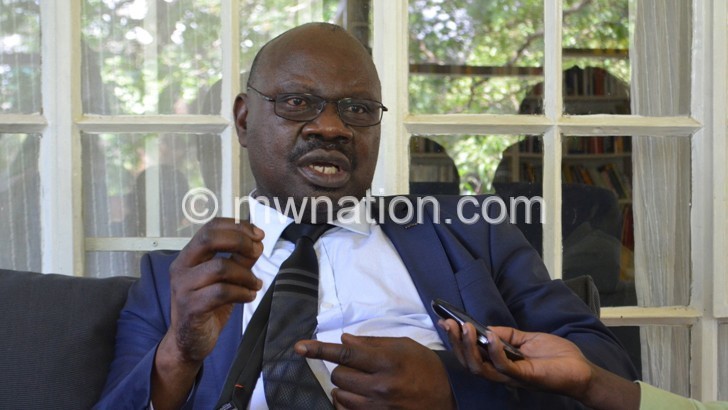Treasury moves To reduce debt
With the country’s fiscal standing under pressure from rising debt levels, Treasury has moved to extend the maturity of domestic debt to over three years and giving parastatals tight control of guaranteed debt to reduce the burden.
In the past four years, the Malawi Government has had to borrow from the domestic market to finance the national budget following poor performance of grants, including direct budget support, as development partners continue to withhold their support over concerns of poor public finance management.
Malawi’s public debt as of June 2018 stood at K2.9 trillion. Out of the debt stock, about K1.5 trillion is domestic debt comprising 62.2 percent in treasury notes, 32.8 percent in treasury bills, 4.4 percent in zero-coupon notes and the rest are advances from commercial banks and promissory notes.

In a report the Secretary to the Treasury Ben Botolo presented to the Budget and Finance Committee of Parliament on the status of public debt as at June 30 2018, the Ministry of Finance, Economic Planning and Development stated that the country’s debt—particularly external—remains sustainable and does not breach international thresholds.
But the report adds: “However, Malawi’s debt is vulnerable to shocks related to exports emanating from weather shocks and changes in commodity prices.”
To this end, Botolo said Treasury has devised measures to reduce debt levels by putting in place strategies to ensure that while government raises funding to keep sectors running, this is done at a minimum risk and costs.
Proposed strategies to ease the burden include lengthening maturity of domestic debt from the maximum 271 days for treasury bills to at least two to three years.
Further reads the report: “Government, through the Reserve Bank of Malawi [RBM], has so far issued two and three-year notes in the 2018/19 financial year with the objective of lenghthening maturities.
“Almost 13 percent of domestic debt is expected to mature in a year. It is envisaged that debt restructuring will assist in reducing the cost of debt and lengthen the maturity profile.”
On his part, Botolo said government realised that the current structure of domestic debt in terms of maturity is fueling the growth of domestic debt.
“Domestic debt, such as treasury bills, has 90, 180 or 271 days and as you can see, they mature within a year. But restructuring to long-term bonds will give fiscal space for them to mature,” he said.
In 2017/18, the national budget was hit with a K45 billion bailout to Agricultural Development and Marketing Corporation (Admarc) after the government guaranteed loans from commercial banks for the purchase of maize.
Botolo said to avoid such fiscal risks, government will put in place policies for managing such contingent liabilities.
“On the proposals is that all SOEs [States Owned Enterprises] with guaranteed debt will have to open an account with the RBM where funds will be deposited on a regular basis for debt servicing.
“Currently, the government is closely monitoring guaranteed debt so as to minimise the likelihood of callouts/materialisation,” the report to the committee reads.
Promissory notes, used to service a K155 billion in arrears discovered in 2014, also contributed to rising domestic debt and the government has not put in place mechanisms to strengthen contract management.
A circular has since been issued imploring Ministries, Departments and Agencies (MDSa) not to overcommit the government without authorisation from Treasury to avoid accumulation of arrears.
Apart from interest payments for accrued arrears and servicing public debt, budget implementation faces pressure from poor domestic revenue collection owing to low industrial production.
About a fortnight ago, Botolo disclosed that the World Bank would not be giving Malawi the much needed K60 billion budgetary support due to disagreements on satisfying some set conditions.
The European Union did not disburse K50 billion which Treasury expected in 2017/18 financial year and disbursement of committed grants was at a slow pace.
Treasury’s strategy is to improve non-tax revenue collection to create fiscal space or surpluses that can be redirected to retiring the existing debt.
“This will include close monitoring and accountability by revenue generating MDAs to make sure that all that is collected is accounted for,” the report reads.
Commenting on the strategies, Catholic University based economist Gilbert Kachamba said while it was possible to implement such plans and they look promising, the government had a bad record of having poor implementation of plans.
“The delay in implementation may be due to several factors some of which may be beyond government control and also to make sure that everybody involved like all stakeholders are involved and have a critical analysis of the impacts and effects. Its better late than never,” he said.
However, Kachamba stressed the need for strong fiscal policies, reducing wastage in the MDAs and encouraging prudence in expenditure to help in reducing government’s appetite too borrow.
Budget and Finance Committee deputy chairperson Winston Chikalimba said at K1.5 trillion, domestic borrowing was reaching dangerous levels and their nature was such that they would have to be paid back.
He said it was encouraging that Treasury was taking steps to reduce the debt and Parliament would monitor implementation of the strategies.
Debt sustainability analysis
At the time that Malawi’s debt was wiped off under the Highly Indebted Poor Countries initiative in 2006, public debt stood at K131 billion of which K62 billion ($450 million) was external debt.
But by 2013, public debt had risen again 78.8 percent of the gross domestic product (GDP) and in the five years since then, total public debt has gone up from K913 billion to K2.9 trillion.
Domestic debt has continued to rise in the past five years, increasing threefold from K523 billion in 2013 to the current K1.5 trillion.
However, a debt sustainability analysis classifies Malawi’s external debt as a moderate risk of debt distress.
Botolo explained that this means it is sustainable but the debt portfolio is exposed to refinancing, interest rate and exchange rate risks.
“Cumulatively, I agree that when you are borrowing it should be at a certain threshold. Ours at 56.8 percent of the GDP which is below 60 percent mark. It will become a problem when we have a domestic currency but cannot pay back foreign debts. That will result in defaults and credit rating being affected,” he said.
In its June 2018 Malawi Debt Sustainability Analysis Report in relation to the Extended Credit Facility (ECF), the International Monetary Fund (IMF) said Malawi remains at moderate risk of debt distress, based on an assessment of external public debt, but added that heightened overall risks remain and reflect vulnerabilities to domestic debt and external conditions.
Reads the IMF report: “Risks of export-related and weather shocks remain, and have materialized since the last DSA. Absorption of weather shocks while maintaining macroeconomic stability and debt sustainability will require careful macroeconomic management and difficult policy choices.
“Close attention will need to be paid to the financing terms of any proposed infrastructure investments given the limited headroom for further borrowing. Similarly, risks of negative financing shocks in the form of delayed donor support, or lower-than-expected revenue collections also remain, given Malawi’s high aid dependency.”
The IMF said in the circumstances, further efforts to maximise the impact of finite domestic resources are required. It said the efforts should include broadening of the tax base and strengthening public procurement and public finance management.n





